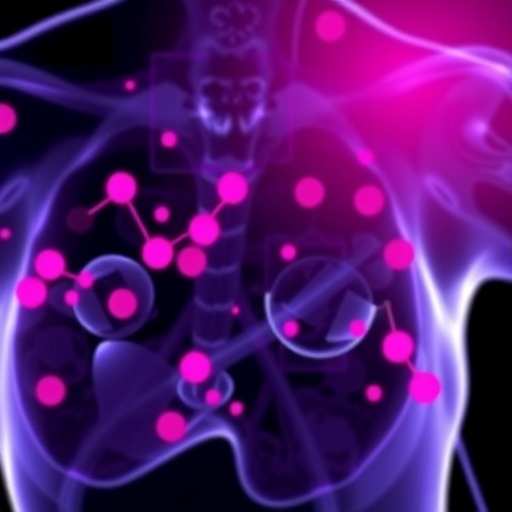In the intricate landscape of breast cancer research, the Ki-67 index has emerged as a pivotal biomarker that encapsulates the proliferative activity within tumor cells. This index is critical not only for prognostic evaluation but also for guiding therapeutic decisions, reflecting the dynamic biology of breast cancer. Despite its recognized importance, the practical application of Ki-67 in everyday clinical settings remains a formidable challenge due to variability in measurement and interpretation. New insights from a comprehensive retrospective study involving 280 breast cancer patients reveal nuanced facets of Ki-67’s prognostic utility and underscore the complexity of translating molecular indices into precise clinical tools.
Ki-67 is a nuclear protein expressed in actively dividing cells, thereby serving as a direct indicator of cellular proliferation. Its quantification commonly relies on immunohistochemical staining, an established laboratory technique that highlights Ki-67-positive cells within tumor samples. However, the evaluation of the proportion of positive cells, commonly termed the Ki-67 index, is fraught with methodological inconsistencies. The recent study confirms that this variability in defining the percentage of Ki-67-positive cells considerably affects survival analysis outcomes, signaling the need for more standardized protocols.
The prognostic relevance of Ki-67 is demonstrated most notably by its correlation with overall survival (OS) and disease-free survival (DFS) among patients with breast cancer. In the analyzed cohort, striking differences in OS were observed when the Ki-67 index varied between 46% and 68%. These differences suggest a threshold effect where proliferation rates beyond certain limits confer a distinctly worse prognosis. Intriguingly, similar patterns emerged when staining density was incorporated into the assessment; however, staining intensity per se provided limited additional prognostic information compared to the simple quantity of positive cells.
Adding another layer of complexity, the study address the widely debated cutoff points for Ki-67. Historically, thresholds such as 14% have been employed to stratify molecular subtypes of breast cancer—a practice validated here by the significant survival disparities between luminal A-type and HER2-overexpressing subtypes at this cutoff. Yet, the findings argue that a rigid cutoff may inadequately capture the continuous nature of tumor proliferation. Instead, interval-based Ki-67 values encompassing ranges between 49% and 60% serve as a more sensitive predictor, especially within subtypes such as HER2-overexpressing breast cancer.
Molecular classification of breast cancer remains a cornerstone of personalized oncology, and Ki-67 interplays actively within this taxonomy. The study highlights significant differences in prognosis across molecular subtypes when Ki-67 thresholds are applied, reaffirming the biomarker’s role in refining subtype definitions. Notably, luminal B HER2-negative patients exhibited divergent outcomes with Ki-67 indices near 52%, emphasizing that proliferation rates intersect critically with hormone receptor status and HER2 expression in shaping disease trajectory.
While Ki-67 quantification remains technically feasible via immunohistochemistry, the study exposes limitations inherent to current clinical practice: subjective assessment of staining and the heterogeneity of tumor samples pose hurdles in reproducibility and clinical applicability. These challenges contribute to the ongoing debate over the biomarker’s role as a definitive prognostic indicator and complicate direct comparisons across studies or treatment centers.
The retrospective nature of this investigation allows for the correlation of Ki-67 with long-term outcomes, enriching our understanding beyond snapshot assessments. Disease-free survival (DFS) showed significant variations within Ki-67 ranges of 50% to 58%, complementing the overall survival data and signaling that Ki-67 not only predicts mortality risk but may also inform relapse patterns.
Integrating Ki-67 into clinical decision-making pathways remains a puzzle. For instance, while high Ki-67 commonly signifies aggressive disease warranting intensive therapy, the precise numerical boundaries that dictate treatment escalation remain elusive. The evidence lends weight to adopting a probabilistic or interval-based framework over a binary cutoff, reflecting the complex biology underlying tumor proliferation.
Distinguishing between staining density and percentage positivity further clarifies how Ki-67 should be interpreted. Although intuitively appealing, staining intensity does not robustly enhance prognostic accuracy beyond what the Ki-67 index conveys. This insight directs pathologists and oncologists to prioritize percentage-based assessments to inform clinical judgments.
The findings of this study resonate with the 2019 Chinese Society of Clinical Oncology (CSCO) consensus recommendations, reinforcing the utility of Ki-67 in dissecting the prognostic landscape of luminal A and HER2-overexpressing breast cancers. These subtype-specific nuances potentially enable tailored therapeutic algorithms, optimizing outcomes based on more refined risk stratification.
Despite the biomarker’s potential, broader clinical adoption of Ki-67-based prognostication demands harmonization of laboratory techniques, standardized scoring systems, and consensus on interpretative criteria. Only through such efforts can Ki-67 transition from a research tool to a robust component of routine clinical protocols.
Future directions must also involve the integration of Ki-67 assessment with emerging molecular analyses, such as gene expression profiling and next-generation sequencing. This multifaceted approach may eventually resolve the limitations inherent to single-marker evaluation and pave the way for multimodal prognostic models that are both precise and practical.
Ultimately, this study illuminates the double-edged nature of Ki-67 in breast cancer management: indispensable yet elusive, powerful yet variable. Harnessing its full prognostic capacity will depend on relentless refinement of assay methodologies, data interpretation frameworks, and collaborative clinical validation, all aimed at confronting the heterogeneity of breast cancer head-on.
As oncology continues to embrace precision medicine, biomarkers like Ki-67 offer a beacon of hope. They promise an era where treatment is not only reactive but predictive, tailored not by guesswork but by the quantifiable biology embedded within each tumor. This research marks a step forward in that long journey, reaffirming Ki-67’s role while candidly confronting the obstacles to its widespread, exacting use.
Subject of Research: The prognostic and predictive role of the Ki-67 index in breast cancer, including challenges in its precise clinical application.
Article Title: Ki-67—Playing a key role in breast cancer but difficult to apply precisely in the real world
Article References:
Wang, C., Chen, J., Lv, X. et al. Ki-67—Playing a key role in breast cancer but difficult to apply precisely in the real world. BMC Cancer 25, 962 (2025). https://doi.org/10.1186/s12885-025-14374-8
Image Credits: Scienmag.com




